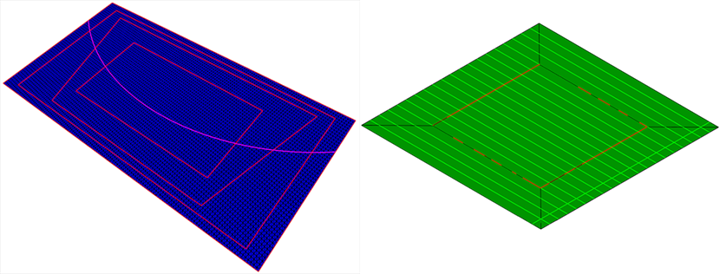Artist Studio algorithm enables near-parallel curve creation on CAD surfaces
Cevotec introduces a novel parallel offset algorithm to its CAD-CAM software for the generation of equidistant curves from a master curve on arbitrary surfaces.
Share
The aim of Cevotec’s (Munich, Germany) CAD-CAM software Artist Studio is to support engineers when designing fiber patch placement (FPP) laminates. Recently, the company worked with the Technical University of Munich (TUM, Germany) to develop an advanced algorithm for the generation of equidistant curves from a master curve on arbitrary surfaces.
According to user-defined laminate parameters and layup strategies, patches will be generated automatically via the Artist Studio software and distributed along so-called guide curves which cover the whole surface of the part. However, Cevotec notes that there is no industry standard yet for generation of such guide curves. Up to now, Artist Studio used a third-party CAM library for the “parallel offset” curve generation process.
There were several challenges to this. First, this limited the ability of the software developers to tailor the algorithm to customer-specific needs. Users also previously faced several restrictions when designing master curves for Artist Studio in their own CAD tools. Ideally, curves were part of the surfaces (limiting flexibility) but were not too close to other edges, thus limiting design freedom). Furthermore, curves ideally also had to start and end exactly on the surface boundary to avoid unexpected behavior of the slave curves.
With the release of the first version of the new parallel offset algorithm, Cevotec has taken steps toward overcoming these limitations in a more robust way. The new algorithm is said to be able to solve certain cases where the third-party solution produces wrong or no results. This is the case when the master curve is not part of the surface for which curves have been created for, or for models where the mesh elements have the exact same size as the chosen offset distance. In terms of performance, the new algorithm is memory-efficient and runs in comparable speed to the third-party solution — and even faster if working with a well-chosen mesh density.
According to the company, the parallel offset method in the context of Artist Studio is an implementation based on a mesh representation of the surface. The task of creating “parallel offset” curves for a general 3D geometry can be described as the creation of equidistant contours, where the considered distance is the geodesic distance along the surface. The process can be logically split into three stages, starting with the conversion of the master curve into corresponding distances, the computation of these geodesic distances and the creation of the resulting slave curves.
The new algorithm is available now for customers with the new Artist Studio. Download it here.
Related Content
-
Optimizing a thermoplastic composite helicopter door hinge
9T Labs used Additive Fusion Technology to iterate CFRTP designs, fully exploit continuous fiber printing and outperform stainless steel and black metal designs in failure load and weight.
-
Nine factors to consider when designing composites cure tooling
Gary Bond discusses the common pitfalls and compromises when designing good cure tooling and their holistic significance for a robust composite production process.
-
Active core molding: A new way to make composite parts
Koridion expandable material is combined with induction-heated molds to make high-quality, complex-shaped parts in minutes with 40% less material and 90% less energy, unlocking new possibilities in design and production.














.jpg;maxWidth=300;quality=90)


